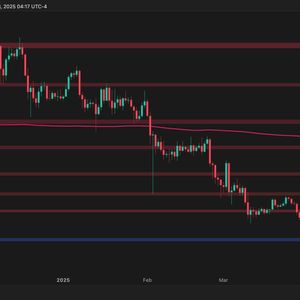In an era of macroeconomic uncertainty and tightening liquidity, Bitcoin (BTC) continues to surprise many with its performance. Concerns regarding inflation and the global economic state, as well as a Federal Reserve that is still sending mixed signals and in much expected “wait and watch” mode, have done little to keep BTC down. In fact, it has punched through all-time-high levels to sit right now at a price above $84,000 and a market cap well above $1.5 trillion. The big question now is whether this ascent can continue. Key Indicators Pointing to Bitcoin’s Bottoming Out Sjuul presents a data-based viewpoint, detailing why the present price movement of Bitcoin might signal the conclusion of its bearish cycle. Here are the main points he makes: 1. Actualized capital losses reach record highs. A crucial indicator of market sentiment is the Realized Cap—a metric that accounts for the value of Bitcoin at the price it was last moved. When Bitcoin is traded at a loss, the Realized Cap shows how much of the market is currently underwater. Recently, Bitcoin’s Realized Cap in loss reached an all-time high (ATH) of $410 billion. According to Sjuul, this is significant because it reflects a broad swath of investors who are sitting at a loss, particularly those who bought BTC after its peak in November. Historically, when this metric hits new highs, it signifies the point at which most investors become unwilling to sell at a loss, often marking the capitulation phase. 2. Short-Term Holder (STH) Losses Reflect the Levels of FTX Mishap Another indicator pointing toward Bitcoin’s potential bottoming out is the state of Short-Term Holders (STH). Typically, these holders have acquired Bitcoin within the past six months. They often capitulate during the formation of a market bottom. Currently, the unrealized losses for these short-term holders have reached levels that are comparable to those seen during the FTX crash. In fact, after looking at charts of unrealized losses, it seems clear that during the crash of August 2024, unrealized losses among STHs were lower than what we are seeing now. When short-term holders are forced to sell at a loss, it often signals that the bottom is in and the price is about to go back up. 3. The Slowdown of Retail Selling Even though Bitcoin has declined from its peak of $109,000 to its current price of $84,000, retail investors are not leading the charge in selling. According to data from CryptoQuant, our smaller investors—that’s the term they use—are often referred to as shrimps. These are investors who hold less than 1 Bitcoin. They have been our primary sellers. In fact, on average, these shrimps have been selling about 480 Bitcoin daily. They haven’t been just holding; they have been selling. Meanwhile, our whales—investors holding over 1,000 Bitcoin—have only been selling around 70 Bitcoin per day. This disparity suggests that retail investors are leading the market to a possible capitulation point. 4. Coinbase Premium is Recovering. Coinbase, one of the largest cryptocurrency exchanges, has witnessed the revival of its Bitcoin premium after it bottomed out in February. The premium is the price difference of Bitcoin traded on Coinbase versus other exchanges. When the premium starts to rise, it is often seen as a sign that institutional investors are returning to the cryptocurrency market and that demand is rising. This recovery is also reminiscent of a similar pattern seen in Q3 2024 when Bitcoin began to move upward after hitting a bottom. We are also seeing fairly steady inflows into Bitcoin ETFs (exchange-traded funds), which also can only serve to increase demand for the asset. 5. Whales Are Accumulating Aggressively Right now, a select number of individuals are amassing vast amounts of supply. Indeed, a current on-chain analysis demonstrates that these individuals have been purchasing and stashing their assets at an aggressive rate. Maybe the clearest sign of a potential bottom is the behavior of whales, large investors who hold massive amounts of Bitcoin. Smart money typically sells at the top and buys at the bottom. Since Bitcoin’s price fell under $85,000, though, these large players have been on the buying side, accumulating aggressively. In just the past six weeks, they have picked up 100,000 BTC, worth a staggering $8.45 billion. Such accumulation—obviously a sign of confidence on the part of the buyers—is a sign not just of potential bottoming behavior but also of a likely uptrend in the relatively near future. The Macro uncertainty is at its highest level. Liquidity is getting drained from the economy, and the FED is still in wait and watch mode. Yet, BTC is trading above $84,000 and outperforming global assets. Here's why I think BTC has bottomed out. A thread: pic.twitter.com/K0ake2abYq — Sjuul | AltCryptoGems (@AltCryptoGems) April 18, 2025 Conclusion: A Gradual Climb Ahead All these pointers together seem to convey that Bitcoin has possibly already reached its nadir or is almost there. Even though the price of Bitcoin may not explode to reach $100,000 next week, the market is presenting a nature of rising back toward a bullish condition again. If the price does break above what seems to be a commanding stuck price point of $100,000, there is a consensus that altcoins will also start rising again back toward their all-time highs. Currently, the indications seem to favor those who think that Bitcoin’s bear market has ended. The next few months should see us move toward a recovery. However, it looks like the recovery may be slow and will likely be punctuated by some volatility. Like always, we need to keep an eye on the overall economy, as these big trends shape the crypto space. Disclosure: This is not trading or investment advice. Always do your research before buying any cryptocurrency or investing in any services. Follow us on Twitter @nulltxnews to stay updated with the latest Crypto, NFT, AI, Cybersecurity, Distributed Computing, and Metaverse news !

















